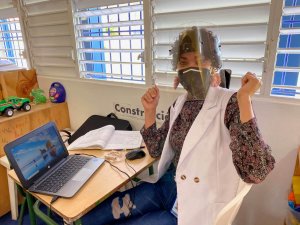Our first step included surveying children’s families to understand their needs and get a handle on the potential obstacles to remote schooling. We also assessed our teachers’ needs. We sourced laptops and tablets for our teachers to prepare lessons. That was the easy part! Few of our children’s homes have a TV, and even fewer have a computer with WIFI. Some can’t even afford a cell phone.
The solution wasn’t ideal, but it had the maximum reach to the students. Our teachers developed weekly study lessons and assignments, packing them with food rations to be delivered to the children’s homes, or to be collected by their parents from Kids Alive sites. Those with cell phones got their study resources via social media along with instructional videos.
“A recent study showed that in some of our communities, less than 10% of students graduate from high school before age 20,” says Vic Trautwein, Country Director, Kids Alive Dominican Republic. He adds, “In sharp contrast to this, Kids Alive students have a graduation rate of over 80%, despite the fact that our kids come from the most challenging circumstances.”
As COVID-19 continues to loom large going into 2021, our teachers have redoubled their resolve to counter its impact on education.
We are grateful to you, our supporters, for continuing to walk alongside us, even as our teachers walk alongside our children.
Thank you!
An interview with Claribel de los Santos, 4th-grade teacher, Constanza School 
Claribel de los Santos has worked for Kids Alive for four years and currently teaches 4th graders at Constanza School.
What do you like about your job?
I love how we support each other and the dedication of my co-workers who have successfully helped at-risk children and youth. I also like to share my faith for the students to know Jesus Christ as their Lord and Savior.
What challenges have faced as a teacher during this pandemic?
I have had difficulty reaching and working with three of my students who have specific academic needs.
How are the children doing?
Many of them do not have food and have to take care of themselves, because their parents work. Some of them walk in the streets sometimes without protection from the virus, because their parents do not take special care of them.
Have you seen anything positive during these times?
Even though my students are far away, the vast majority of my students have remained connected with me and their academic performance has not changed.
I have many very dedicated parents with grateful hearts willing to work as co-teachers at home.
What are the challenges you’ve faced teaching during the pandemic?
Distance teaching and reaching all 100% of my students at home is the biggest challenge. Additionally, I must work with parents who now also have to play “teacher” at home. It is also challenging to prepare interesting and diverse activities to challenge and maintain the interest of students and grow their academic capacity without face-to-face contact.
Several difficulties include establishing regular connections with three students in particular and helping several students that have very specific academic needs. In one case, I was able to help motivate a particularly unmotivated student by getting him on a social media conference call where several of his friends could offer him encouragement.
What has been difficult for the students?
Students face many difficulties, including challenges with parents who can’t read and write and hence cannot support them with school activities. Other parents turn violent and mistreat children for not knowing an assignment or for other reasons.
Have you come across any encouraging events?
One morning, a mother came to school looking for her child’s schoolwork for the following week. She was anguished and told me that her child does not want to study with her. She explained, “He is frustrated because I don’t know how to read so cannot explain the assignments to him.”
The student had no access to a phone so we couldn’t talk. The mother went and bought a cell phone and hooked it to their neighbor’s wi-fi and I was able to talk to this student. I was able to reassure him and explain the importance of the schoolwork. It changed him. I now call him every day to help him and explain his lessons. So far, he is doing well with his activities and interaction with me.

Ark Jarabacoa academic coordinator Romery circulates among the multigrade classrooms to give extra assistance and guidance. Many of our residential children arrive in our care behind in their schooling, this is a great opportunity to provide some "catch-up" education as well as forge deep connections.

Palo Blanco office staff Raquel, sorts through completed assignments that are ready for grading. The reviewing and grading of classwork has required detailed and creative planning. Our teachers trained in Trauma Competent Care, approach students struggling to complete their work with an awareness and understanding that there may be larger issues behind delayed assignments.

Palo Blanco School teachers Hember, Eric, and Ana Alba enjoy a moment of comradery while planning lessons and devotions for their students. Although held on the school campus, discipleship “Club” is an important time for students to connect it helps prevent at-risk teens from pregnancy, alcoholism, and drug abuse, as well as school dropouts.

Rosanny , teacher, Santo Domingo East, visits her 4th graders as she is concerned about their wellbeing. *Amanda presented her with a beautiful letter full of love and a desire to be back at school. Home visits challenging as the Dominican government has curfews in place as well as a mandatory mask requirement and a prohibition of students on school campuses.

Director Luz Angela, Constanza School, and her staff created detailed COVID-19 safety protocols for parents to visit the school campus for parent-teacher meetings and exchange of completed and new schoolwork assignments. Hand disinfection, masks, and proper distancing are all enforced to ensure everyone’s safety.










